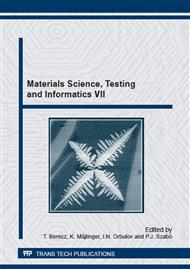p.59
p.65
p.71
p.77
p.83
p.89
p.95
p.101
p.107
Degradation Behaviour of Zeolite Filled Polyurethanes under In Vitro Aging Process
Abstract:
In this study the degradation and ion/zeolite release processes of in vitro aged zeolite loaded polyurethane composites were evaluated. Two in vitro artificial aging solutions were used; artificial lysosomal fluid (ALF) and Gamble ́s solution and the total exposure time was 12 weeks. Periodically, SEM micrographs were taken of the surface of polyester type polyurethane-zeolite composites. After exposure to ALF solution the samples showed round holes and a rougher surface in general over time. Micrographs of the samples immersed in Gamble’s solution exhibited different signs of degradation with damage features on the surfaces, understood as black holes and a rougher surface pattern. In addition varying amount of salt was also observed on the surfaces that might influence the ion/zeolite release. Furthermore, the zeolite filler caused remarkable changes in mechanical properties after the aging process, which could not be discerned.
Info:
Periodical:
Pages:
83-88
Citation:
Online since:
February 2015
Authors:
Price:
Сopyright:
© 2015 Trans Tech Publications Ltd. All Rights Reserved
Share:
Citation:


